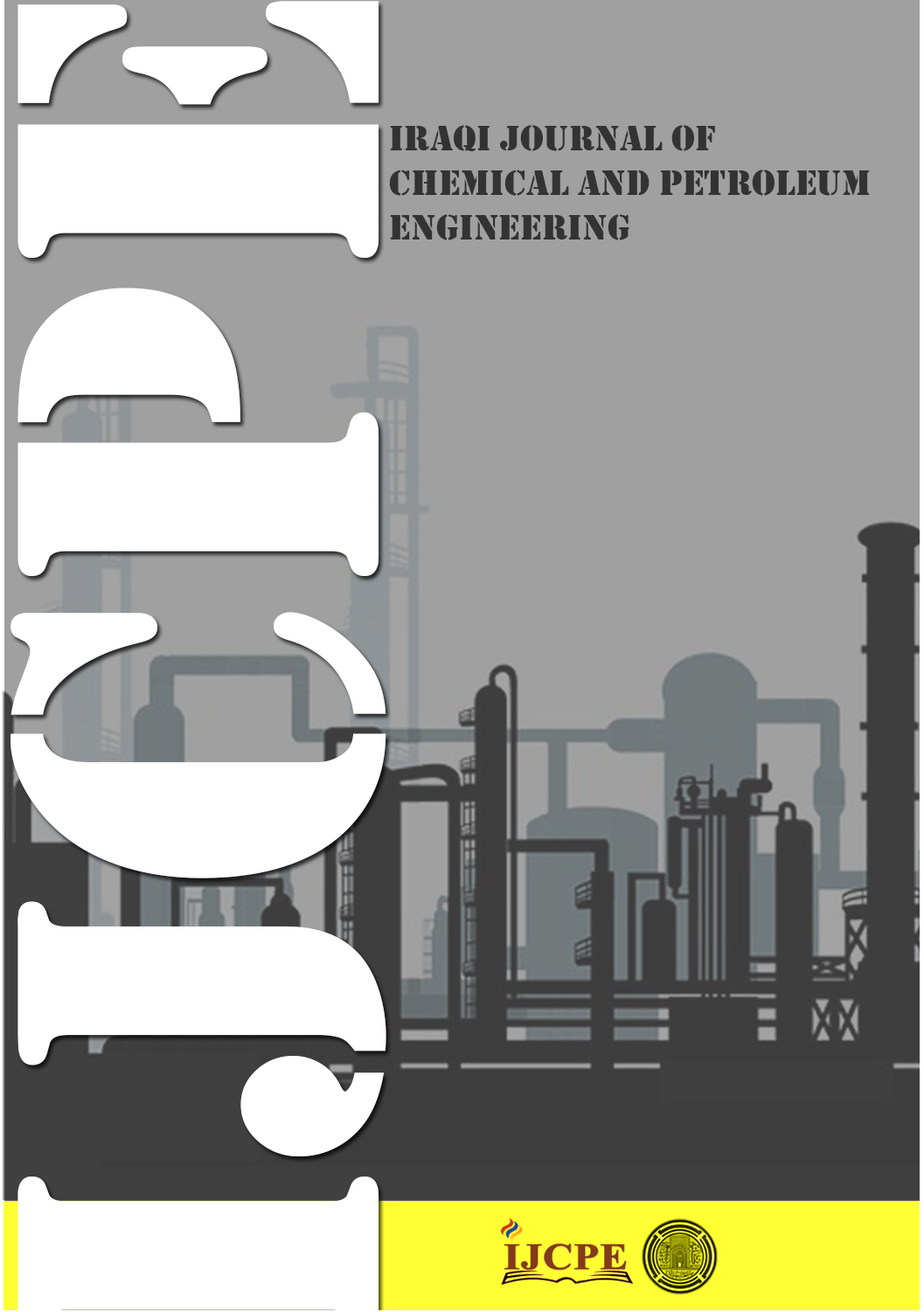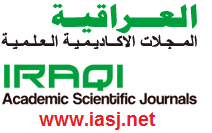Tracking metabolic gases in an airlift bioreactor for enhanced microalgae cultivation
DOI:
https://doi.org/10.31699/IJCPE.2025.3.1Keywords:
Mass transfer; airlift bioreactor; microalgae; sparging; carbon dioxideAbstract
Airlift bioreactors have been classified as a promising technology for microalgae cultivation. Several improvements have contributed to increasing the mixing efficiency and production. However, some challenges are still facing this biological process. One challenge is the efficient dissolution and delivery of carbon dioxide to microalgae cells, which remains a limiting factor in the biological processes. On the other hand, sparging the gas in large quantities may lead to gas loss if microorganisms do not completely consume it. In this study, microalgae were cultivated in two stages and compared: the first stage of injecting 5 ml of carbon solution into a conical flask and the second stage of sparging 5 liters/hour in an airlift bioreactor with increasing sparging time this is done by sparging carbon dioxide gas at the same flow rate from day to day, but increasing the sparging time by 30 seconds, starting with sparging the gas for one minute until reaching 7 minutes. The results showed that the airlift bioreactor gives a higher growth rate of microalgae than that produced in a conical flask. The maximum biomass concentration reached 5 g/L in the airlift bioreactor culture with a maximum specific growth rate of 0.324 day−1, while it reached 1.0799 g/L in the conical flask culture with a specific growth rate of 0.187 day−1. This result shows the importance of the airlift bioreactor in microalgae cultivation. Also, the internal composition of the biomass was found that the airlift bioreactor was the best, as the amount of lipids, carbohydrates and protein was (2.06, 1.43, and 18.03 g per 30 g of dry biomass), respectively, while the internal composition of the control cultivation was (0.005386, 0.00428, 0.05754 and g/L), respectively. The volumetric mass transfer coefficient showed that when the sparging time increases, the oxygen gas transfer coefficient increases until it reaches 1.0397 s−1. The pH value was also maintained around 7, which is the appropriate value for increasing the growth rate.
Received on 03/04/2025
Received in Revised Form on 07/05/2025
Accepted on 08/05/2025
Published on 30/09/2025
References
[1] V. Ramanathan, “The Greenhouse Theory of Climate Change: A Test by an Inadvertent Global Experiment,” Journal of Science, vol. 240, no. 4850, pp. 293–299, Apr. 1988, https://doi.org/10.1126/science.240.4850.293
[2] C. Song, “Global challenges and strategies for control, conversion and utilization of CO2 for sustainable development involving energy, catalysis, adsorption and chemical processing,” Journal of Catalysis Today, vol. 115, no. 1–4, pp. 2–32, Jun. 2006, https://doi.org/10.1016/j.cattod.2006.02.029
[3] E.-H. Chang and S.-S. Yang, “Some characteristics of microalgae isolated in Taiwan for biofixation of carbon dioxide,” Botanical Bulletin of Academia Sinica, vol. 44, 2003.
[4] S. M. A. Mobin, H. Chowdhury, and F. Alam, “Commercially important bioproducts from microalgae and their current applications-A review,” Journal of Energy Procedia, vol. 160, no. 2018, pp. 752–760, 2019, https://doi.org/10.1016/j.egypro.2019.02.183
[5] E. Daneshvar, R. J. Wicker, P. L. Show, and A. Bhatnagar, “Biologically-mediated carbon capture and utilization by microalgae towards sustainable CO2 biofixation and biomass valorization – A review,” Chemical Engineering Journal, vol. 427, no. May 2021, p. 130884, 2022, https://doi.org/10.1016/j.cej.2021.130884
[6] H. C. Eilertsen et al., “Mass Cultivation of Microalgae: I. Experiences with Vertical Column Airlift Photobioreactors, Diatoms and CO2 Sequestration,” Applied Sciences journal., vol. 12, no. 6, p. 3082, Mar. 2022, https://doi.org/10.3390/app12063082
[7] A. Shahid et al., “Cultivating microalgae in wastewater for biomass production, pollutant removal, and atmospheric carbon mitigation; a review,” Science of the Total Environment, vol. 704, p. 135303, 2020, https://doi.org/10.1016/j.scitotenv.2019.135303
[8] M. Dębowski et al., “The effects of Microalgae Biomass Co-Substrate on Biogas Production from the Common Agricultural Biogas Plants Feedstock,” Journal of Energies, vol. 13, no. 9, p. 2186, May 2020, https://doi.org/10.3390/en13092186
[9] A. V. T. Yadugiri, “Milking diatoms – a new route to sustainable energy.” Current Science Association, vol. 97, no. 6, pp. 748–750, 2009.
[10] W. H. Khor et al., “Microalgae cultivation in offshore floating photobioreactor: State-of-the-art, opportunities and challenges,” Aquaculturing Engineering, vol. 98, p. 102269, Aug. 2022, https://doi.org/10.1016/j.aquaeng.2022.102269
[11] Y. Sun, D. Hu, H. Chang, S. Li, and S.-H. Ho, “Recent progress on converting CO2 into microalgal biomass using suspended photobioreactors,” Bioresource Technology, vol. 363, p. 127991, Nov. 2022, https://doi.org/10.1016/j.biortech.2022.127991
[12] N. Hajinajaf et al., “Managing carbon dioxide mass transfer in photobioreactors for enhancing microalgal biomass productivity,” Algal Research, vol. 80, p. 103506, Jun. 2024, https://doi.org/10.1016/j.algal.2024.103506
[13] Z. Zarei, P. Malekshahi, M. H. Morowvat, and A. P. Trzcinski, “Hydrodynamic performance of algal bioreactors,” Algal Bioreactors, Elsevier, 2025, pp. 121–133. https://doi.org/10.1016/B978-0-443-14058-7.00043-9
[14] S. Drandev, K. I. Penev, and D. Karamanev, “Study of the hydrodynamics and mass transfer in a rectangular air-lift bioreactor,” Chemical Engineering Science, vol. 146, pp. 180–188, Jun. 2016, https://doi.org/10.1016/j.ces.2016.02.041
[15] K. Akita and F. Yoshida, “Gas holdup and volumetric mass transfer coefficient in bubble columns. Effects of liquid properties,” Industrial and Engineering of Chemistry Process Design and Devlopment., vol. 12, no. 1, pp. 76–80, 1973, https://doi.org/10.1021/i260045a015
[16] A. I. Galaction, D. Cascaval, C. Oniscu, and M. Turnea, “Prediction of oxygen mass transfer coefficients in stirred bioreactors for bacteria, yeasts and fungus broths,” Biochemical Engineering Journal, vol. 20, no. 1, pp. 85–94, 2004, https://doi.org/10.1016/j.bej.2004.02.005
[17] C. O. Chambers, “The Relation of Algae to Dissolved Oxygen and Carbon-Dioxide. With Special Reference to Carbonates,” Missouri Botanical Garden Annual Report, vol.1912, no. 1912, p. 171, 1912, https://doi.org/10.2307/2400038
[18] I. Abed, G. Abdulhasan, and A. Najem, “GENOTYPE VERSUS PHENOTYPE TO DETERMINE THE DEFINITIVE IDENTIFICATION OF THE GENERA CHLORELLA BEIJERINCK, 1890 (CHLORELLACEAE) AND COELASTRELLA CHODAT, 1922 (SCENDESMACEAE),” Bulletin of the Iraq Natural History Museum, vol. 15, no. 1, pp. 101–111, Jun. 2018, https://doi.org/10.26842/binhm.7.2018.15.1.0101
[19] Z. H. Razooki, M. K. H. Al-Mashhadani, and I. J. Abed, “Biomaterial composition of the microalga Coelastrella sp. (MH923012): Effect of carbon source,” Materials Today: Proceedings, vol. 20, pp. 621–626, 2020, https://doi.org/10.1016/j.matpr.2019.09.200
[20] R. S. Mahdi, M. K. H. Al-Mashhadani, and I. J. Abed, “Pre-dissolved Inorganic Carbon (DIC) for cultivation Chlorella sorokiniana MH923013, Coelastrella MH923011 and Coelastrella MH923012,” IOP Conference Series: Materials and Science Engineering, vol. 1076, no. 1, p. 012025, 2021, https://doi.org/10.1088/1757-899x/1076/1/012025
[21] H. A. Hassan, M. K. H. Al-Mashhadani, K. M. Abed, and I. J. Abed, “The optimal utilization of lighting factor in the flat photobioreactor for biological applications,” Materials Today: Proceedings, vol. 42, pp. 2534–2540, 2021, https://doi.org/10.1016/j.matpr.2020.12.575
[22] A. R. Mulakhudair, M. Al‐Mashhadani, J. Hanotu, and W. Zimmerman, “Inactivation combined with cell lysis of Pseudomonas putida using a low pressure carbon dioxide microbubble technology,” Journal of Chemical Technology and Biotechnology, vol. 92, no. 8, pp. 1961–1969, Aug. 2017, https://doi.org/10.1002/jctb.5299
[23] R. Zevenhoven, “Mass transfer, Mass transfer,” Fortran Programs for Chemical Process Design, Analysis, and Simulation, pp. 469–589, 2012.
[24] S. Y. Chiu, C. Y. Kao, M. T. Tsai, S. C. Ong, C. H. Chen, and C. S. Lin, “Lipid accumulation and CO2 utilization of Nannochloropsis oculata in response to CO2 aeration,” Bioresource Technology, vol. 100, no. 2, pp. 833–838, 2009, https://doi.org/10.1016/j.biortech.2008.06.061
[25] M. K. H. AL-Mashhadani and E. M. Khudhair, “Experimental Study for Commercial Fertilizer NPK (20:20:20+TE N: P: K) in Microalgae Cultivation at Different Aeration Periods,” Iraqi Journal of Chemical and Petroleum Engineering, vol. 18, no. 1, pp. 99–110, Mar. 2017, https://doi.org/10.31699/IJCPE.2017.1.8
[26] B. Ketheesan and N. Nirmalakhandan, “Feasibility of microalgal cultivation in a pilot-scale airlift-driven raceway reactor,” Bioresource Technology, vol. 108, pp. 196–202, 2012, https://doi.org/10.1016/j.biortech.2011.12.146
[27] M. G. de Morais and J. A. V. Costa, “Carbon dioxide fixation by Chlorella kessleri, C. vulgaris, Scenedesmus obliquus and Spirulina sp. cultivated in flasks and vertical tubular photobioreactors,” Biotechnology Letters, vol. 29, no. 9, pp. 1349–1352, Sep. 2007, https://doi.org/10.1007/s10529-007-9394-6
[28] M. G. de Morais and J. A. V. Costa, “Biofixation of carbon dioxide by Spirulina sp. and Scenedesmus obliquus cultivated in a three-stage serial tubular photobioreactor,” Journal of Biotechnology, vol. 129, no. 3, pp. 439–445, 2007, https://doi.org/10.1016/j.jbiotec.2007.01.009
[29] H. Gimmler, “Acidophilic and Acidotolerant Algae,” Algal Adaptation to Environmental Stresses, Berlin, Heidelberg: Springer Berlin Heidelberg, 2001, pp. 259–290. https://doi.org/10.1007/978-3-642-59491-5_9
[30] M. J. Makki, M. K. H. Al-Mashhadani, and S. K. Al-Dawery, “Removal of Ranitidine Using Chlorella Sorokiniana MH923013,” Iraqi Journal of Chemical and Petroleum Engineering, vol. 24, no. 2, pp. 31–39, Jun. 2023, https://doi.org/10.31699/IJCPE.2023.2.4
[31] J. U. Grobbelaar, “Algal Nutrition ‒ Mineral Nutrition,” in Handbook of Microalgal Culture, Wiley, 2003, pp. 95–115. https://doi.org/10.1002/9780470995280.ch6
[32] K. Kumar and D. Das, “Growth characteristics of Chlorella sorokiniana in airlift and bubble column photobioreactors,” Bioresource Technology, vol. 116, pp. 307–313, 2012, https://doi.org/10.1016/j.biortech.2012.03.074
[33] A. Kazbar et al., “Effect of dissolved oxygen concentration on microalgal culture in photobioreactors,”Algal Research, vol. 39, no. January, p. 101432, 2019, https://doi.org/10.1016/j.algal.2019.101432
[34] J. V. Moroney, N. Jungnick, R. J. Dimario, and D. J. Longstreth, “Photorespiration and carbon concentrating mechanisms: Two adaptations to high O2, low CO2 conditions,” Photosynthesis Research, vol. 117, no. 1–3, pp. 121–131, 2013, https://doi.org/10.1007/s11120-013-9865-7
[35] C. U. Ugwu, H. Aoyagi, and H. Uchiyama, “Influence of irradiance, dissolved oxygen concentration, and temperature on the growth of Chlorella sorokiniana,” International Journal for Photosynthesis Research, vol. 45, no. 2, pp. 309–311, 2007, https://doi.org/10.1007/s11099-007-0052-y
[36] kazeem k. Salam, A. O.arinkoola, M. D.aminu, and O. Sanni, “modelling of mass transfer coefficient of co2 in stirred tank bio- reactors using response surface methodology (rsm),” Petroleum and coal, vol. 61, no. 5, pp. 1015–1024, Jul. 2019.
[37] H. Chaumat, A. M. Billet-Duquenne, F. Augier, C. Mathieu, and H. Delmas, “Mass transfer in bubble column for industrial conditions—effects of organic medium, gas and liquid flow rates and column design,” Chemical Engineering Science, vol. 60, no. 22, pp. 5930–5936, Nov. 2005, https://doi.org/10.1016/j.ces.2005.04.026
[38] G. Li, W. Xiao, T. Yang, and T. Lyu, “Optimization and Process Effect for Microalgae Carbon Dioxide Fixation Technology Applications Based on Carbon Capture: A Comprehensive Review,” C-Journal of Carbon Research, vol. 9, no. 1, 2023, https://doi.org/10.3390/c9010035
[39] S. L. Al-Dulaimi and A. M. Al-Yaqoobi, “Separation of oil/water emulsions by microbubble air flotation,” IOP Conference Series: Materials. Science and Engineering, vol. 1076, no. 1, p. 012030, 2021, https://doi.org/10.1088/1757-899x/1076/1/012030
[40] A. M. G. Al-Yaqoobi and W. B. Zimmerman, “Relative wettability measurement of porous diffuser and its impact on the generated bubble size,” Chemical and Process Engineering - Inzynieria Chemiczna i Procesowa, vol. 43, no. 1, pp. 45–55, 2022, https://doi.org/10.24425/cpe.2022.140810
[41] Z. H. Razooki, I. J. Abed, and M. K. H. Al-Mashhadani, “Effect of the aqueous carbon source on growth rate of the Microalgae Coelastrella sp. MH923012,” Plant Archives, vol. 19, pp. 1420–1425, 2019.
[42] D. Tang, W. Han, P. Li, X. Miao, and J. Zhong, “CO2 biofixation and fatty acid composition of Scenedesmus obliquus and Chlorella pyrenoidosa in response to different CO2 levels,” Bioresource Technology, vol. 102, no. 3, pp. 3071–3076, 2011, https://doi.org/10.1016/j.biortech.2010.10.047
[43] H. H. Abd El Baky, G. S. El-Baroty, and A. Bouaid, “Lipid Induction in Dunaliella salina culture aerated with various levels CO2 and its biodiesel production,” Journal of Aquaculture Research and Devlopment., vol. 5, no. 3, 2014, https://doi.org/10.4172/2155-9546.1000223
[44] M. J. Griffiths and S. T. L. Harrison, “Lipid productivity as a key characteristic for choosing algal species for biodiesel production,” Journal of Applied Phycology, vol. 21, no. 5, pp. 493–507, Oct. 2009, https://doi.org/10.1007/s10811-008-9392-7
[45] H. S. Yun, Y. S. Kim, and H. S. Yoon, “Characterization of Chlorella sorokiniana and Chlorella vulgaris fatty acid components under a wide range of light intensity and growth temperature for their use as biological resources,” Heliyon, vol. 6, no. 7, p. e04447, 2020, https://doi.org/10.1016/j.heliyon.2020.e04447
[46] S.-J. Lee, S. Go, G.-T. Jeong, and S.-K. Kim, “Oil production from five marine microalgae for the production of biodiesel,” Biotechnology and Bioprocess Engineering, vol. 16, no. 3, pp. 561–566, Jun. 2011, https://doi.org/10.1007/s12257-010-0360-0
Downloads
Published
Issue
Section
License
Copyright (c) 2025 The Author(s). Published by College of Engineering, University of Baghdad.

This work is licensed under a Creative Commons Attribution 4.0 International License.













